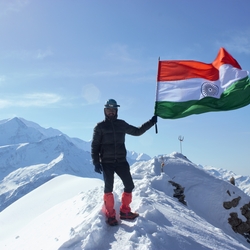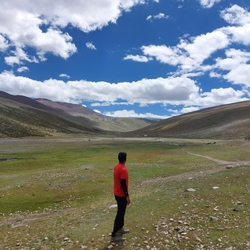Located amidst the Sahyadris in Maharashtra, Harihar Fort is a blend of history, nature and adventure! Built by the Yadava dynasty on a triangular rock, the fort is at an altitude of 1120M with steep rock cut steps leading you to the top. The climb is steep but rewarding with views of surrounding villages, the Sahyadri ranges and other nearby forts. This one day trek to the fort is enhanced during monsoons with the lush green colour of the hills, the mist and clouds that feel like they are an arm’s reach away.
This article lays down all the information pertaining to the Harihar Fort trek and is your go to guide when planning this trail!
The Harihar Fort Trail
The trail starts close to the Nirgudpada bus stop in a village called Kotamwadi. The initial part of the trail is fairly easy, taking you through farms, fields and a number of streams. The green colour of the fields with streams cutting through is only a teaser of what is to come. The trail continues like this for the first half an hour and Harihar fort is visible on the right in the distance.
As you pass the fields, the trail gradually inclines into a forest and open lands from where you get views of the fort. The trail leads you to a plateau from where the most challenging part of the trek starts.

The Rock Cut Steps
The trail from the plateau to the top of the fort is steep and challenging given the rock cut steps that have to be navigated. The steps are almost inclined at 80 degrees, making it a thrilling climb to the top. While incline of the steps might sound scary, there is ample support mechanism in place to keep you safe. Navigating these steps during the monsoon can be tricky with moss growth and water making the steps slippery. A pair of trekking shoes and a trekking pole go a long way in making your climb more comfortable, offering you the much needed grip and support on the steep and slippery sections.
The first section of steps take you to the Mahadarvaja after which you reach a traverse. The traverse drops into a valley on your left and is fortified on the right. Beyond the traverse lies the second set of stairs and a cave which take you to the top of the fort.
You can find small ponds and shrines dedicated to Hindu gods and goddesses in the fort. From here you can go to the highest point of the fort to get panoramic views of the Sahyadris around you. Take a minute to soak in the beauty of the landscape before you make your way down.

The descent can be challenging on the rock cut steps so it is important to be extremely careful and take all the support you need.
Highlights: Things to Look Forward to on This Trek
1. Intricate Architecture and the Rock Cut Steps
Harihar Fort is definitely an architectural marvel given that it is built on a triangular prism shaped rock. The rock cut steps to the top stand out in particular with their 80 degree inclination, making it a challenge to climb them. Although challenging and tricky, climbing the steps is the most adventurous and exciting part of the trail!
2. Panoramic Views of the Sahyadris
The highest point of the fort offers 360 degree views of the Sahyadris and surrounding villages. During monsoon, the thick layer of green and the mist from the clouds enhance the beauty of the place. Take a moment to yourself as you soak in the grandiosity of the blend of hills and plains around you.

Challenges: Things ro be Prepared For on This Trek
1. Rock Cut Steps
Adventurous and exciting as they are, the rock cut steps are the most difficult part of the trek. They are narrow and steep, making it tricky to navigate your way up. Make use of the support system put in place and wear shoes that offer a good grip to your feet. And remember not to look back if you are someone who is scared of heights!
2. Trekking in Monsoon
The western ghats receive high rainfall and the Sahyadris are no exception to it. During monsoon, water is often gushing down the rock cut steps, triggering the growth of moss and making the steps slippery. Climbing the steps during this time can be challenge. Be vary of your step and ensure you get a solid grip before moving forward. Trust me, trekking shoes and a trekking pole really are your best freinds!
3. Steep Ascent
The climb from the plateau is steep and you might find yourselves out of breath if you are not in the best of health and fitness. Minimal excercise goes a long way in improving your stamina, making you better prepared for the trail.

Difficulty Level and the Bikat Rating Scale
Harihar Fort is a level 1 trek on the Bikat Rating Scale.
About the BRS: The Bikat Rating Scale rates the difficulty level of all treks and expeditions in our portfolio after taking into account their geographical and climatic conditions.
According to this scale, if you are a beginner who is unsure of your fitness level and don’t know what to expect on a trek, a trek rated one will be a good place to start.
If you liked your very first trekking experience and are looking to test your limits next, the treks rated 2 or 3 will do the job for you.
A beginner who is sure of their fitness level on the other hand is welcome to skip the first two levels and directly start with one of the treks rated 3.
From 4 onwards, the rules change a little. It is mandatory to have trekking experience of the previous level to participate in the next level.
Best Time to do the Harihar Fort Trek
Monsoon and post monsoon is the best time to do this trek. June to January make for ideal months to climb up to the fort with lush green Sahyadris surrounding you in the monsoon months and clear views in the winters with bearable temperatures. The summer months can be dry and extremely hot.
How to Reach the Base
Nirgudpada village is the base location for the Harihar Fort trek. It can be reached by a private vehicle and public transport is also available. From the Mumbai airport, Nirgudpada is around 170 kms by road. Nashik Railway station is 55 kms away and Pune is at a distance of 255 kms.
If you are travelling from Mumbai, you can take a local train to Kasara. From here you have to get a cab to Khodala and then a shared taxi to Nirdgudpada. If you are travelling from Nashik, you can get a bus to Trimbakeshwar and then a cab to Nirgudpada. Pune is further away compared to Mumbai and Nashik. The best way to reach from Pune would be to get a bus to Nashik or Mumbai and then travel to Nirgudpada.
Frequently Asked Questions about Kudremukh Trek
1. Is there network and connectivity during the trek?
You will have cellular networks for most parts of the trail. You might lose connectivity occasionally and on the top, particularly if the weather is bad.
2. Are there any food stalls on the trail?
The base village has a number of dhabas to choose from. The plateau before the rock cut steps also has a few food stalls that sell snacks.
3. Do we require any permits for this trek?
There is no need for any permits or clearances from the forest department for this trail as of now.
4. How long does the trek take?
The trail itself is not too long (3.5-4 kms) and can be completed in a day.
5. Is this trail for beginners?
Harihar Fort can be attempted by beginners with minimal preparation. However, ensure you take proper care and support while climbing the steep sections of the trail.
That’s all about the Harihar Fort trek! Should you wish to know more or need help planning your weekend adventure to the Sahyadris, please feel free to reach out to our team.






